Using design for manufacture and assembly, Laing O’Rourke has delivered a major new hospital in Wales under budget and four months early – no wonder the government is looking to use it as a model for its hospital building programme. Thomas Lane reports
A major new hospital in Cwmbran, Wales, opens next week that could be the model for Boris Johnson’s aspirations to build 40 hospitals by 2030. Directly funded by the Welsh government, it is a happy story of a £350m hospital opening four months early, a first for a hospital of this size. It has also come in under budget.
In March, with the pandemic spiralling out of control, the health board asked the contractor Laing O’Rourke if the wards could be delivered earlier than scheduled. The project team pulled out all the stops and, in the space of five weeks, handed over the ward areas a year early so these could be used for patients with covid-19. This saved millions building a temporary Nightingale hospital.
The key reason for this success is that the Grange University Hospital represents the pinnacle of Laing O’Rourke’s investment and its belief that design for manufacture and assembly (DfMA) is the future of construction. When the contract was signed in 2017 Laing O’Rourke had been investing in DfMA for nearly 10 years. “What we did is take the best of what Laing O’Rourke has produced over 10 years and introduced it into this job,” says Mike Lewis, project director for the Grange.
The success of this project has secured Laing O’Rourke an invitation to the Cabinet Office to discuss how this approach could be used to help the prime minister in his aspiration to build 40 hospitals in less than 10 years. So, how was the Grange delivered so quickly and could this model be used to help Johnson achieve his aspiration?
There is much more to this job than a three-year build programme and a finished hospital. Detailed planning started in 2007, which means it has taken three times longer to press “go” than actually to build it. Victoria Head, Gleeds’ project manager for this job, says she did some work to assess how long it takes for healthcare projects to get to site. She says: “When healthcare projects go over the £75m threshold, the average journey is between 10 and 12 years from conception to start on site.”
There are various reasons for the delay. The Aneurin Bevan University Health Board wanted to create a new model of healthcare, with the Grange functioning purely as a dedicated critical care facility. All other healthcare was to be handled by other hospitals in the region.
It took time to get this model right. Recession has played its part, with uncertainty about spending so much money on one big hospital. Crucially for the new hospital roll-out programme, adopting modern methods of construction to build the hospital also contributed to the delays.
If you could design a structure that could be common across 20 hospitals, then we could provide the product for other people to build
Mike Lewis, Laing O’Rourke
Gleeds and Laing O’Rourke started working with the health board over 10 years ago. Gleeds was acting as the client’s project and cost manager, with Laing O’Rourke brought in early on to advise on the best way to deliver the scheme.
The health board was open to new ways of delivering the hospital but was also cautious about using DfMA as no major UK hospital had been delivered using this approach to this extent before. According to Head, there was a lot of convincing to be done. “We had to do a huge amount of work to demonstrate to the health board and the Welsh government that this was the right thing to do. By that, I mean that we could prove value for money, and that this could be an efficient and sustainable way to build the hospital.”
As part of the business case, Gleeds modelled a traditionally built hospital and one constructed using modern methods of construction. According to Lewis, the advantage of the latter approach is that Laing O’Rourke’s experience with DfMA meant it knew exactly how long it takes to manufacture and install each component, which gives greater cost certainty.
Gleeds established that the traditionally built hospital would take 179 weeks and one delivered using DfMA would take 137 weeks, a 23% saving. But this came at a 0.5% cost premium.
Head says: “On £350m that 0.5% is still relatively significant. However, offset that against the 23% programme savings are the prelims, which were running at £1m a month. The savings are enormous.”
The second challenge was the tension between the client’s desire for competitive tendering and the need to ensure seamless interfaces between all the suppliers to maximise the efficiencies offered by DfMA. Laing O’Rourke employs what it calls an integrated delivery model. This means the whole job pivots around the product so the project has to be carefully designed using BIM to precisely plan the job element by element.
The advantage is that the factory knows when each component needs to be manufactured and when it has to be dispatched to site. The site team knows when components are arriving and need to be installed. Even crane movements can be modelled to ensure they are used to the full.
Given the need for this Swiss-watch precision, it removes risk and uncertainty for Laing O’Rourke to use its own supply chain which is familiar with this approach. Laing O’Rourke wanted to use its in-house companies including Expanded for piling and superstructure, Explore to manufacture the components, Crown House for the MEP and Select for the plant.
Both Head and Lewis say strict procurement rules and client hesitancy about this lack of competition meant Gleeds and Laing O’Rourke had to demonstrate value for money. The team duly went through the process, which Head says cost a “huge amount of money”.
She adds: “Demonstrating value for money is important but it costs money to do that. Presentationally yes, it looks like it is saving money, but how much do you have to invest to prove that you have saved money?”
Once the budget of £350m was settled, the client and Laing O’Rourke agreed to share risk with the signing in October 2017 of an NEC contract, whereby client and contractor share the benefits of coming in under budget or the pain of exceeding it.
Laing O’Rourke’s early involvement coupled with the long gestation process meant there was plenty of time to understand what the client wanted and work up and refine the design, including ensuring it was DfMA friendly. The contractor appointed and worked with architect BDP from the outset under the terms of the Design for Life framework used to procure the hospital.
“Because we are in right at the beginning with a blank sheet of paper, we are in a position to influence the team to deliver the best DfMA approach that we can and demonstrate the benefits to the client team,” explains David Leverton, Laing O’Rourke’s regional design leader.
The precast facade panels are a good example of process optimisation. These can go up to a maximum panel size of 3.7m x 13m, but this necessitates the use of a low loader that can carry only one panel at a time. Reducing the panel size, in the case of the Grange, to 3.2m x 7.8m enables a standard lorry to deliver two panels.
The Grange has a 4.2m floor-to-floor height – the gap above each panel is infilled by a smaller, spandrel panel. There is considerable design flexibility within these constraints, including multiple window configurations, and the concrete can be coloured and given a surface treatment – for example, smooth or fluted.
We had to do a huge amount of work to prove value for money, and that this could be an efficient and sustainable way to build the hospital
Victoria Head, Gleeds
The project took Laing O’Rourke’s experience with DfMA onwards a step. The frame is constructed from precast columns and the floor slab from Laing O’Rourke’s lattice slabs, which arrive as a flat panel complete with reinforcement in some areas and precast hollow-core slabs elsewhere. These are topped with concrete to achieve a structural, flat slab. This project used more double-height columns than on previous projects; these have the benefit of offering double the structure for close to the same amount of handling.
Another step forward was improved digital integration between the design and manufacturing process. BDP and structural engineer WSP worked up the design for the facade panels in 3D and sent these to Explore for manufacturing. The amended design went back to WSP and BDP for reviewing and checking, then advising the factory of any changes.
“This is the first time we’ve managed to do this purely in the model environment,” says Leverton. He says the design team send the information to the factory as a 3D model but the factory sends back amendments for review in 2D format for a traditional check. On this job the software has been improved so the factory can send back their information as a 3D digital model. “The level of the detail on this project that could be checked was significantly greater because they could see where a shadow gap starts and stops or whether a chamfer has actually been detailed. In the 2D world that is almost impossible to pick up on on every single panel and to make sure that shadow gap aligns with the shadow gap on the adjacent panel.”
The big benefit of this approach is that it removes the risk of mistakes that could disrupt the programme. Leverton says: “If there is an issue with a panel that isn’t spotted until it is offloaded on site and installed, then you’ve got enormous disruption to the process because your programme is basically on hold in that area – it is probably three weeks before you get a new panel.” This has a knock-on effect on the planned sequencing for that part of the project.
Other process refinements include fitting the windows to the panels at the factory. This is much easier to do because the window installers are working at ground level in a predictable environment and all the quality control for a completed panel can be done before dispatch to site. This has the benefit of eliminating the need for scaffolding as the completed panels are simply craned into position. Elsewhere prefabricated risers and bathroom pods for the ward areas saved a lot of time. The rest of the fit-out has to be done traditionally due to its highly specialised, bespoke nature.
Targets
How did Laing O’Rourke do against its own targets to transform its business into an efficient, DfMA-first business? The targets were: 70:60:30, meaning 70% of construction conducted offsite, a 60% improvement in productivity, and a 30% reduction in time. Excluding fit-out, Laing O’Rourke achieved 50%‑55% of offsite construction, a 45% productivity improvement and a 23% saving on the programme. What could it do on the next job to move the business closer to these targets?
Some hospital areas need the flexibility to make future changes to be baked into the design. Wards feature a consistent, relatively fixed layout that is unlikely to change over the life of the building, making them ideal candidates for offsite construction. Other areas, notably diagnostics, need greater adaptability to allow reconfiguration as technology evolves. Leverton describes the diagnostics area as a “chassis” with a precast frame but not precast panels as these are difficult to reconfigure. Instead a lightweight steel-framed facade has been installed as this can be easily removed.
The downside is that a lightweight steel frame is relatively time-consuming to build, in an area which Laing O’Rourke would have liked to have got watertight earlier because of the complex fit-out. This facade was going to feature insulated panels using a foam type insulation. The team decided to switch to rockwool in light of the Grenfell disaster. This made the panels much heavier, necessitating a crane to lift them into position. “In effect, we were using hook time for relatively small components,” says Leverton, adding that this time could have been used to lift precast panels. With the benefit of hindsight, the sides of the diagnostic unit could have been built using the precast panels, reserving the ends for the lightweight steel facade.
The time savings and predictability of budgeting offered by DfMA means this is a good model for rolling out other hospitals. But the public sector would need to get over the bureaucratic approach to procurement and involve design and construction teams right at the start of projects, which is still the exception rather than the norm. The other issue is that no other main contractor is as far down the DfMA route as Laing O’Rourke, which limits capacity.
Lewis says the reality is many of the hospitals that the government has promised to be completed by 2030 are extensions and refurbishments of existing buildings which could be handled conventionally. He adds that Laing O’Rourke has the capacity to build five hospitals concurrently, but the factory could produce enough components to build double that because it is only working single shifts and not all the equipment is fully used.
“If you could design a structure that could be common across 20 hospitals, then we could provide the product for other people to build,” says Lewis. This suggests the industry is ready to step up to the challenge laid down by Boris Johnson. Now it is up to the prime minister to sort out his end of the bargain.
Project Team
Client Aneurin Bevan University Health Board
Architect BDP
Cost and project management Gleeds
Structural engineer WSP
MEP Aecom
Contract supervision Arup
Contractor Laing O’Rourke
Frame, facade, MEP and pod manufacture Explore
Piling and superstructure Expanded
MEP installation Crown House Technologies
Plant supplier Select





















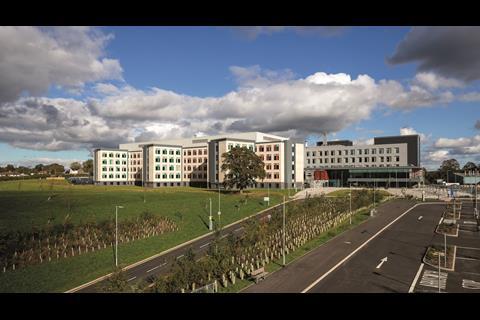
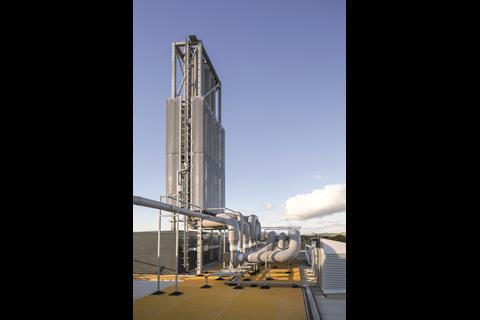
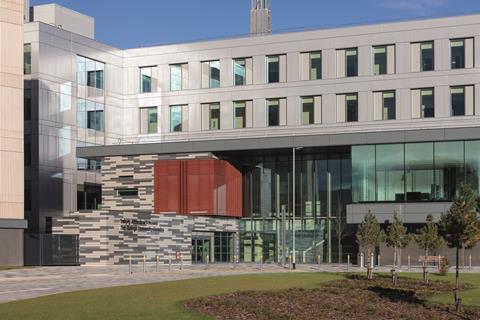
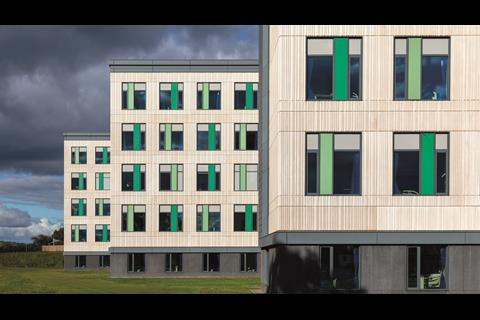
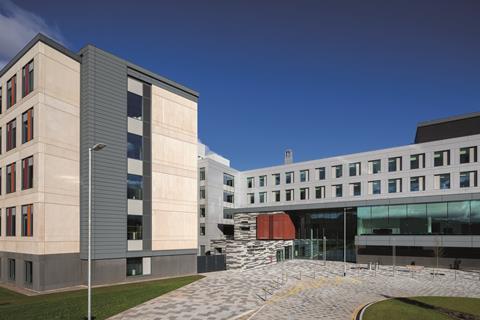

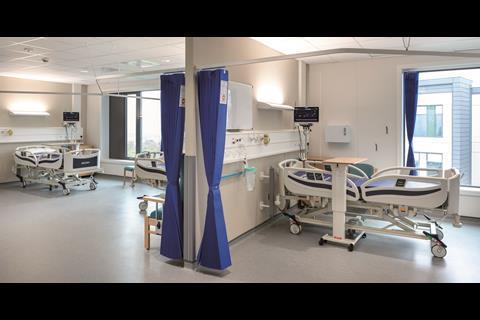
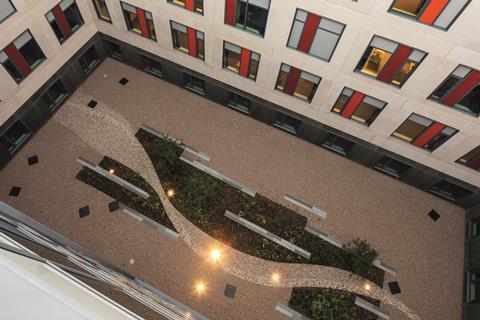
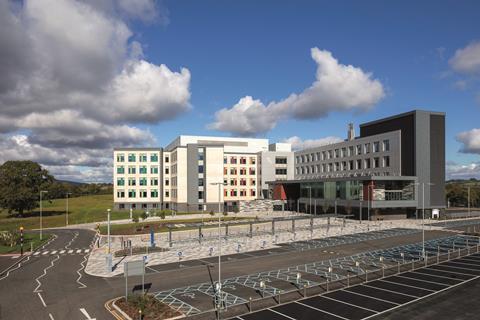








No comments yet